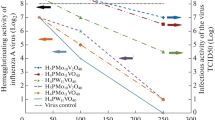Summary
The effect of chloroquine diphosphate on the growth of polio type 1, influenza, Newcastle disease, Sendai, vesicular stomatitis and vaccinia viruses was studied. Host dependency of the antiviral effect of chloroquine on Newcastle disease and Sendai viruses was shown using HeLa S 3 cells and primary chick embryo fibroblast cells.
The antiviral effect of chloroquine was extensively studied in chick embryo cells infected with vesicular stomatitis virus. Chloroquine at a concentration of 12.5 μg per ml markedly reduced the virus yield. The drug did not affect the adsorption of vesicular stomatitis virus to chick embryo cells. No evidence for inhibition of the virus uncoating process by the drug was obtained in our present system. The addition of chloroquine at various times after the latent period induced immediate inhibition of the synthesis of progeny virus. Chloroquine inhibited selectively the synthesis of viral RNA without affecting that of cellular RNA or the synthesis of viral antigens.
Similar content being viewed by others
References
Allison, A.: Lysosomes in virus-infected cells. In: “Perspectives in Virology”5, pp. 29–61, New York and London: Academic Press, 1967.
Bray, G. A.: A simple efficient liquid scinzillator for counting aqueous solutions in a liquid scintillation counter. Ann. Biochem.1, 279–285 (1960).
Cohen, S. N., andK. L. Yielding: Inhibition of DNA and RNA polymerase reactions by chloroquine. Proc. nat. Acad. Sci. (Wash.)54, 521–527 (1955).
Dales, S.: An electron microscope study of the early association between two mammalian viruses and their hosts. J. Cell Biol.13, 303–322 (1962).
Dales, S.: The uptake and development of vaccinia virus in strain L cells followed with labelled viral deoxyribonucleic acid. J. Cell Biol.18, 51–72 (1963).
Dales, S., andP. W. Choppin: Attachment and penetration of influenza virus. Virology18, 489–493 (1962).
Dales, S., P. J. Gomatos, andK. C. Hsu: The uptake and development of reovirus in strain L cells followed with labelled viral ribonucleic acid and ferritin-antibody conjugates. Virology25, 193–211 (1965).
Dales, S., andR. Kajioka: The cycle of multiplication of vaccinia virus in Earle's strain L cells. 1. Uptake and penetration. Virology24, 278–294 (1964).
Dales, S., andL. Siminovitch: The development of vaccinia virus in Earle's L strain cells as examined by electron microscopy. J. biophys. biochem. Cytol.10, 475–503 (1961).
David-Ferreira, J. F., andR. A. Manaker: An electron microscope study of the development of a mouse hepatitis virus in tissue culture cells. J. Cell. Biol.24, 57–78 (1965).
Dulbecco, K.: Production of plaques in monolayer tissue cultures by single particles of an animal virus. Proc. nat. Acad. Sci. (Wash.)38, 747–752 (1952).
Dulbecco, R., andM. Vogt: Plaque formation and isolation of pure lines with poliomyelitis viruses. J. exp. Med.99, 167–182 (1954).
Franklin, R. M.: Studies on the growth of vesicular stomatitis virus in tissue culture. Virology5, 408–424 (1958).
Girardi, A. J., H. McMichael Jr., AndW. Henle: The use of HeLa cells in suspension for the quantitative study of virus propagation. Virology2, 532–544 (1956).
Green, M. H., andE. L. Verney: A simple method for the study of intracellular acid phosphatase in HeLa cells. J. Histochem. Cytochem.4, 106–109 (1956).
Kashiwazaki, H., andN. Ishida: Inhibition of Sendai virus by N1-Isobutyl-biguanide hydrochloride as studied by immunofluorescent staining. Proc. Soc. exp. Biol. (N.Y.)120, 139–143 (1965).
Kohno, S., M. Kohase, andM. Suganuma: Inhibition of interferon production by chloroquine diphosphate. Jap. J. med. Sci. Biol.21, 239–248 (1968).
Mallucci, L.: Effect of chloroquine on lysosomes and on growth of mouse hepatitus virus (MHV-3). Virology28, 355–362 (1966).
Marshall, J. D., W. C. Eveland, andC. W. Smith: Superiority of fluorescein isothiocyanate (Riggs) for fluorescent antibody technic with a modification of its application. Proc. Soc. exp. Biol. (N.Y.)98, 898–900 (1958).
O'Brien, R. L., J. G. Olenick, andF. E. Hahn: Reactions of quinine, chloroquine, and quinacrine with DNA and their effects on the DNA and RNA polymerase reactions. Proc. nat. Acad. Sci. (Wash.)55, 1511–1517 (1966).
Weissmann, G.: Labilization and stabilization of lysosomes. Fed. Proc.23, 1038–1044 (1964).
Yielding, K. L.: Inhibition of the replication of a bacterial DNA virus by chloroquine and other 4-aminoquinoline drugs. Proc. Soc. exp. Biol. (N.Y.)125, 780–783 (1967).
Author information
Authors and Affiliations
Rights and permissions
About this article
Cite this article
Shimizu, Y., Yamamoto, S., Homma, M. et al. Effect of chloroquine on the growth of animal viruses. Archiv f Virusforschung 36, 93–104 (1972). https://doi.org/10.1007/BF01250299
Received:
Issue Date:
DOI: https://doi.org/10.1007/BF01250299




